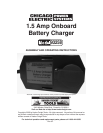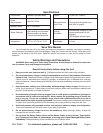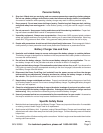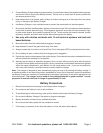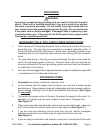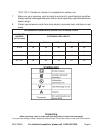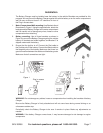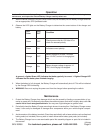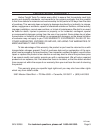
Page 2SKU 93258
For technical questions, please call 1-800-444-3353.
Specifications
Construction: Molded PolyPlastic Body Output: 12 VDC at 1.5 AMPS
Power
Requirements:
120 VAC, 60 Hz
Required Power
Input Cord:
3-prong grounded power cord,
see chart on page 6
Battery Cables 24” L x 18 AWG
Safety Features:
Self-resetting circuit breaker
Reverse polarity protected
Thermal overload protected
Charge
Controller:
Automatically changes to “float”
charge when battery is fully
charged.
LED charged indicator lights.
Dimensions: 6-
5
/
8
”L x 3-
9
/
16
”W x 1-
9
/
16
”H Net Weight: 2.0 Lbs.
Save This Manual
You will need the manual for the safety warnings and precautions, assembly instructions, operating
and maintenance procedures, parts list and diagram. Keep your invoice with this manual. Write the invoice
number on the inside of the front cover. Keep the manual and invoice in a safe and dry place for future
reference.
Safety Warnings and Precautions
WARNING: When using tool, basic safety precautions should always be followed to reduce the
risk of personal injury and damage to equipment.
Read all instructions before using this tool!
1. Keep your work area clean and well lit. Cluttered benches and dark areas invite accidents.
2. Do not operate battery charger in explosive atmospheres, such as in the presence of flammable
liquids or dust. Batteries and battery chargers may create sparks which may ignite the dust or fumes.
Caution must be exercised when charging, hydrogen, an explosive gas, is released when charging
lead-acid batteries. Always allow proper ventilation to the charger and battery and keep the hood open
during use.
3. Keep bystanders, children, and visitors away while operating a battery charger. Distractions can
cause you to lose control. Protect others in the work area from debris such as corrosion materials and
sparks. Provide barriers or shields as needed.
4. Grounded battery chargers must be plugged into an outlet properly installed and grounded in
accordance with all codes and ordinances. Never remove the grounding prong or modify the
plug in any way. Do not use any adapter plugs. Check with a qualified electrician if you are in
doubt whether the outlet is properly grounded. If the battery charger should electrically malfunction
or break down, grounding provides a low resistance path to carry electricity away from the user.
5. Avoid body contact with grounded surfaces such as pipes, radiators, ranges, and refrigerators.
There is an increased risk of electric shock if your body is grounded.
6. Do not expose battery charger to rain or wet conditions. Water entering a battery charger will
increase the risk of electric shock.
7. Do not abuse the Battery Cables. Never use the Battery Cables to carry the tool. Keep the Bat-
tery Cables away from heat, oil, sharp edges, or moving parts. Replace damaged Battery Cables
immediately. Damaged Battery Cables increase the risk of electric shock.



